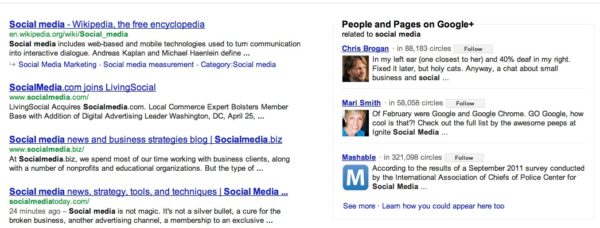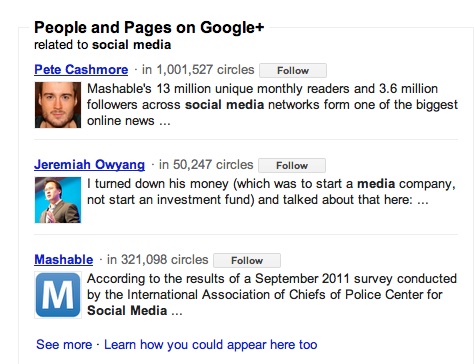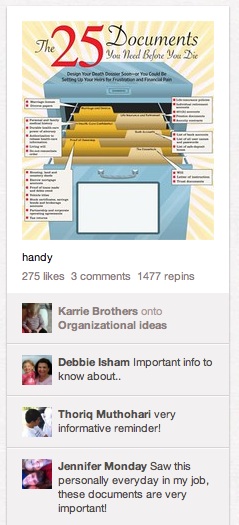Google’s searchbots have long relied on humans to endorse relevant and useful links. Recently, however, Google upped the human ante by introducing Google Social Search.
Google recognizes that one personal endorsement from someone we know easily outranks endorsements from 10,000 strangers. The same applies for a trusted authority: a blogging link shared by Darren Rowse or Brian Clark carries more weight than something a casual user shares.
So as a result, we have Google Social Search: meaning a site can jump from #30 to #3 in the SERPs just because someone in your Google+ circles shared the link. Getting an RT from The Huffington Post can jump your blog post from #8 to #1. It’s a brave new world of social SEO – and it’s one that no SEO can afford to ignore.
Leveling The Playing Field
Under traditional SEO practices, a modern startup would have no chance at ranking for highly competitive keywords. The other sites have been down in the trenches too long; it’d be nearly impossible to knock them off their SERP pedestal without years of campaigning.
Social SEO makes it easier for smaller fish to compete with the big guys. A tweet that receives a viral-size number of retweets can mean as much as a link from a top-ranking site; a +1 from a friend can send your site to the top of the social SERPs for that friend’s entire network.
Social media should already be a part of your business strategy. Now it’s time to harness the power of those social media accounts for your SEO strategy – or risk falling behind while your competitors cash in on their social chips.
Social Strategies To Start Employing Today
1. Ramp Up Your Google+ Presence
It’s the most obvious one on the list, but it still needs to be said. Like it or not, Google has made it clear that G+ is here to stay – and it’s become too useful for an SEO not to take advantage it.
Though the network is still a lightweight compared to sites like Twitter and Facebook, Google+ is emerging as a champion heavyweight in search results.
As seen in the screenshot below, casual G+ posts are even showing up in search results:

Think Google+ search results are just limited to social search? Think again. Related Google+ users and pages show up in standard Web search, too:

From authorship to +1s to shares to circle numbers, Google is injecting social G+ results into nearly every Google Social search. Jumping to a first-page ranking solely because someone put you in a G+ circle? That’s a benefit no site can afford to ignore.
2. Put A New Emphasis On Building Relationships & Increasing Followers
Everything you write or share can pop up in your followers’ search results – even if they’re not a member of the social site you shared the link on. The relationships we forge online now have a huge impact on our search results.
Every new follower you get may see your brand’s site in his or her SERPs in the future, so it’s in your best interest to ramp up your follower count. Host a giveaway (entrants must follow you on G+, for example), increase your outreach efforts, or give away an eBook exclusively for your followers.
3. Start Posting Your Articles Immediately On Social Media
As Mitch Monsen of White Fire SEO pointed out, tweeting your content actually helps your content get indexed faster (especially vital if you’re posting time-sensitive material). Set your articles to automatically post on Google+, LinkedIn, etc. and you’ll get indexed even quicker.
4. Focus On Shareable Content
Social shares have always worked in a SEO’s favor by granting us endorsements similar to direct inbound links. Now, shares have another benefit: if someone (even someone that doesn’t follow you on any social media sites) shares your content, the sharer’s entire network may see the post by searching for relevant material in Google Social Search.
Getting someone like, say, Newsweek to share your material? In addition to getting a nice boost in your rankings, you’ll also have access to that power user’s network.
5. Add +1 Buttons To Anything & Everything
Have you noticed that Google’s even added +1 buttons to their ads? The +1 has turned into an Internet-wide Facebook like button.Don’t turn down the easy endorsement: slap the +1 button on your site wherever you can.
6. Use “Rel=author” & “Rel=me” Tags To Link Your Work To Your Name

Searchers can now see thumbnails of the person who authored the article they’re about to read. If they liked what they read, they can simply return to the SERP and click “More by ________” to see the author’s entire catalogued body of work.
To clue Google in that you’re the author, you’ll need to use “rel=author” tags in your posts. Not sure how? Joost de Valk’s already written a comprehensive guide on the subject – and so has Google.
7. Get On Pinterest
 I know it’s rapidly becoming a cliché to write about Pinterest, but the newest social site on the block has well-earned its praise due to its sheer SEO power.
I know it’s rapidly becoming a cliché to write about Pinterest, but the newest social site on the block has well-earned its praise due to its sheer SEO power.
This simple graphic from The Wall Street Journal nabbed the website nearly 1500 shares on Pinterest (and countless more traffic):
You probably already know Pinterest sends nearly as much referral traffic as Twitter (and more than YouTube, G+, and LinkedIn combined), but did you know Google now crawls pins and boards?
Optimize your pins for relevant search keywords; further optimize for Pinterest searches by hashtagging relevant keywords on each pin.
8. Add A “Pin It” & A StumbleUpon Button To Your Site
Take the shares anywhere you can get them. The aforementioned Pinterest has killer link traction, while the social bookmarking powerhouse StumbleUpon is second only to Facebook in terms of referral traffic.
Slap both “Pin It” and StumbleUpon buttons on your content right next to the Facebook, Twitter, and +1 buttons.
A Brief Word To The SEO Traditionalists
Am I suggesting social SEO practices are rapidly replacing traditional SEO methods?
Absolutely not.
Am I suggesting social SEO is better than traditional SEO?
Absolutely not.
Traditional SEO isn’t going anywhere any time soon. However, as social becomes increasingly integrated with search, it’s time to add social media as a permanent tool in our SEO arsenal.
Opinions expressed in the article are those of the guest author and not necessarily Search Engine Land.








